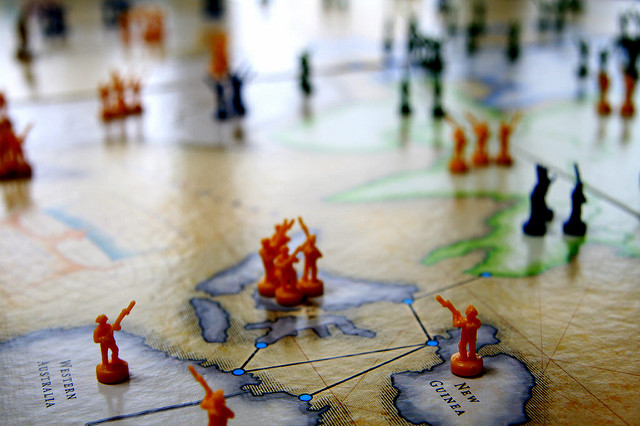 China’s adventurism in the South China Sea has prompted a change in Australian policymaking that merits wide international attention. In making maintenance of a “rules-based global order” a core strategic priority, Australia’s new Defence White Paper adopts language not often found at the heart of national defense charters. It is all the more surprising coming from a conservative government that is usually keen to follow the United States down any path it takes.
China’s adventurism in the South China Sea has prompted a change in Australian policymaking that merits wide international attention. In making maintenance of a “rules-based global order” a core strategic priority, Australia’s new Defence White Paper adopts language not often found at the heart of national defense charters. It is all the more surprising coming from a conservative government that is usually keen to follow the United States down any path it takes.
Australia wanted a readily defensible basis for contesting China’s claims that could not be portrayed as just another reflexive embrace of the American position. For a country trying—as are others in the region—to avoid zero-sum choices between our strategic partner, the US, and our economic partner, China, the White Paper’s words were astutely chosen and deserve emulation.
Part of the attraction of a “rules-based global order” is that it would constrain all relevant players. US policymakers, unlike those in most of the rest of the world, don’t find the concept inherently attractive. Although they—like everyone else—do pay lip service to it, willingness to be bound by international rules is not part of US officials’ DNA.
The invasion of Iraq in 2003 remains Exhibit A. But there are others, including the overreach (alongside the United Kingdom and France) of the UN Security Council’s mandate in Libya in 2011, and what Jessica Mathews has described as the ‘wasteland for multilateral commitments’ in the US approach to binding treaties, including the Convention on Biodiversity, the Comprehensive Nuclear Test Ban Treaty, the Protocol on Torture, and, most relevant to the South China Sea, the UN Convention on the Law of the Sea (UNCLOS).
The more immediate sting in the Australian White Paper is for China. Whatever else is going on in the South China Sea, it is not respect for a rules-based global order. Playing by the rules would imply a number of changes to Chinese behavior.
First, it would mean clearly articulating specific sovereignty claims, based on long use or occupancy of particular habitable islands, in the Paracel or Spratly groups or elsewhere. When those claims overlap with claims by other states, as most of them do, China must be prepared to resolve them, preferably by international adjudication or arbitration, which it has so far strongly resisted, or at the very least by genuine give-and-take negotiation.
Second, China would have to abandon its “nine-dash line” as a basis not only for sovereignty claims relating to land features bounded by it, but also for claims to ill-defined “historical waters” or “traditional Chinese fishing grounds.” With Chinese fishing vessels constantly intruding into what have hitherto been others’ undisputed 200-nautical-mile exclusive economic zones (EEZs) under UNCLOS, these claims are now causing real friction with countries like Indonesia.
UNCLOS—now generally accepted as customary international law even by countries that have not joined it, like the US—is the only acceptable framework for resolving these issues. Even if every one of China’s current sovereignty claims to particular habitable islands were to be accepted, the 12 nautical miles of territorial waters, and the 200 nautical miles of EEZ associated with each of them, would not begin to add up to the 80% of the South China Sea now encompassed by China’s nine-dash line.
Third, China would need to limit severely its actions relating to reefs and shoals, never previously habitable, where it has been reclaiming land and building airstrips and other installations capable of military use, and seeking to deny others’ the use of adjacent waters and airspace. International law tolerates some such building—as the Philippines, Vietnam, and Malaysia have been doing for years, though on a much smaller scale. But it does not tolerate any military use, or support more than a 500-meter “safety zone” around such installations—not a territorial sea, EEZ, “air defence identification zone,” or anything else.
Fourth, China should moderate its position that no foreign ship or aircraft may engage in surveillance or intelligence collection not only within its territorial waters, about which international law is clear, but within its entire EEZ, about which China’s argument is not at all strong. Adherence to this position sustains a constant risk of inflammatory incidents.
So long as China refuses to play by accepted international rules, others are entitled to push back, including with the fly-by or “freedom of navigation” sail-by exercises in which the US has been engaging, and which Australia and others should separately emulate. China’s insistence that it has no intention to disrupt commercial shipping or flight lanes should be believed; to do otherwise would be to cut off its nose to spite its face. But its behavior is testing the limits of regional and global understanding and patience.
The remaining attraction of making a “rules-based global order” central to Australia’s policy is the discipline this imposes on Australia itself—as it would on any state that adopts this language. To be taken seriously, we have to put our money where our mouths are, by accepting international duties and responsibilities—like helping to stop atrocity crimes in faraway places—that are consistent with our claims to good international citizenship but serve no immediate traditional national security or economic interest.
In Australia’s case, this means thinking again about some of our efforts to limit our exposure to the International Court of Justice and certain dispute-resolution mechanisms under UNCLOS. In this imperfect world, there is considerable tolerance for all sorts of imperfect behavior. But hypocrisy always catches up with you. Preaching the virtues of a rule-based order to others, but being coy about some of those rules oneself, is not a good look.

